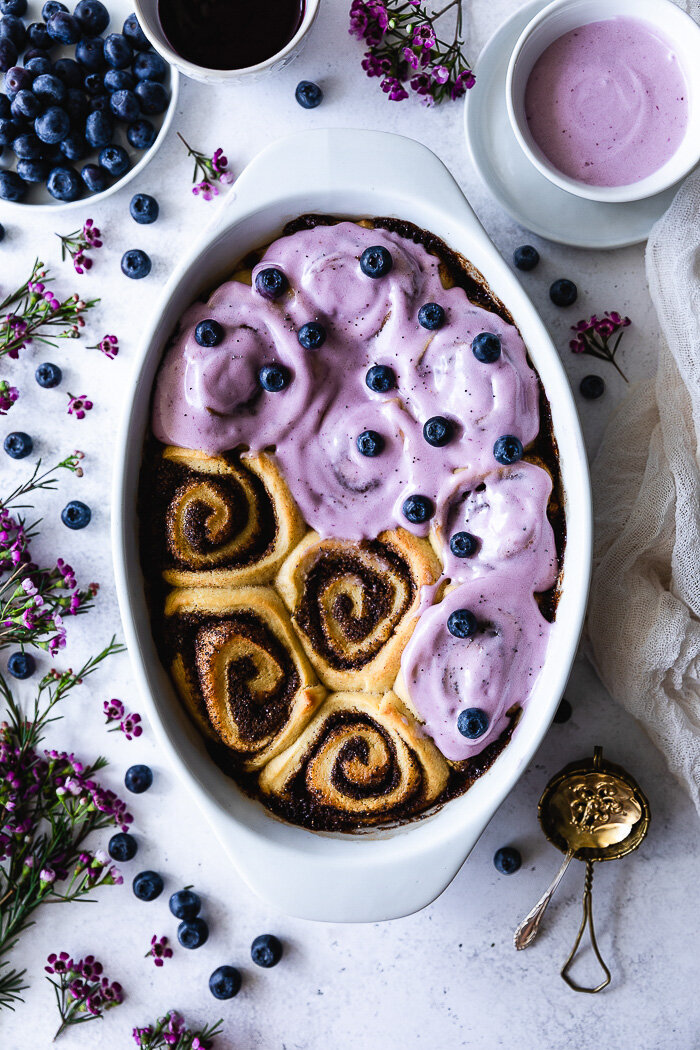How to Make a Simple Glaze
Let’s say that if you know how to make a simple glaze you have already a world full of possibilities in your very own hands. A traditional sugar glaze is no other thing than confectioner’s sugar combined with a liquid or spread. The composition and amount of that second component will determine the final texture of your glaze, from thin and translucent to saturated and hard. From there you can play with different flavored liquids or spreads to create a glaze that goes perfectly with the flavors of that recipe you’ve been wanting to make since a long time now.
Making a glaze is super easy but there are some useful tips and steps that you can follow when making one. That way you’ll end with the kind of glaze that you want, in the amount that you want and with the least possible mess. Because let’s face it, it could definitely be kind of messy. Here are my tips for you!
How to Make a Simple Glaze even without a recipe
It’s super important to sift the powdered sugar. That is if you want to make your life easier. I’m always up for a clever shortcut in the kitchen, but I’m sorry to report that there’s no shortcut when it comes to sifting the sugar. It has to be done in order to end up with a silky and smooth glaze. Unless you are heating in the stove your mixture for hot glazes. And even there, a good sifting using just a hand whisk is very welcome. What I like to do is to place a big sieve on a medium or large bowl, depending on how much glaze I’m going to make. I then dump some of the sugar on the sieve and sift either by scrapping the bottom of it with a spoon or by tapping it on the sides with the palm of my hands. I continue to do this until I have sifted all my sugar.
Always use a hand whisk to mix.
No matter the glaze, I always like to use a bit of freshly squeezed lemon juice. A few drops for chocolate, dulce de leche, cinnamon or other warm notes based glazes; a bit more for hibiscus, vanilla or floral and fruity notes glazes. This bit of lemon will be part of the liquid you need to make the glaze.
A little liquid goes a long way when making a glaze. Always start with half of the amount of liquid the recipe is asking and then add more if you still want to make it thinner. On the other hand, if you added too much by mistake and want your glaze thicker, place again the sieve on top of the bowl and sift about ¼ cup of powdered sugar and whisk again.
For thick glazes you’ll need about 1 cup of powdered sugar and probably a bit less of 1 tablespoon of liquid. This will be enough for a regular Bundt dripping glaze such as the one on this Banana Bread for example. For a very light and translucent glaze you’ll need 1 cup of sugar and about 4 tablespoons of liquid. In a few weeks I’ll be uploading a recipe using this kind of runny glaze so stay tune and you’ll see how light and transparent it is. Same applies to creamy based glazes.
For an extra hard, thick and saturated glaze that won’t leave any residue after you touch it, mix a cup of sifted sugar with very little water (practically drops) to form a thick paste. You’ll probably think it’s not enough for a Bundt or cinnamon rolls but that’s ok. Heat the glaze in the microwave to make it runny. Immediately spread it through your bakes. This glaze will get very hard after it dries out.
Glazes made with clear liquids such as water, clear juices, tea and clear liquors are the ones that you can touch and it won’t stick to your fingers after completely dry. That’s not the case with glazes made with creamy liquids such as milks, spreads (cream cheese, dulce de leche, nut butters) or creamy liquors (Bailey’s, etc.) In this case the glaze will be kind of gooey even after dry and probably you’ll leave a small indentation on it if you touch it.
You may store any glaze leftovers on the fridge. Clear liquids based glazes will last longer than creamy based glazes; they could be good for several weeks. When ready to use, let it come down to room temperature and mix well again using a hand whisk because there’s a chance the liquid had separated. Add a few drops of water or fresh lemon juice if it is too stiff.
Now go and bake something. You need a place to drizzle some glaze! You can use it on any of these recipes:
Fluffy Cinnamon Rolls with Blueberry Glaze






